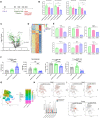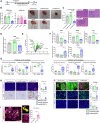Exosome-mediated genetic reprogramming of tumor-associated macrophages by exoASO-STAT6 leads to potent monotherapy antitumor activity
- PMID: 35179953
- PMCID: PMC8856615
- DOI: 10.1126/sciadv.abj7002
Exosome-mediated genetic reprogramming of tumor-associated macrophages by exoASO-STAT6 leads to potent monotherapy antitumor activity
Abstract
Effectiveness of checkpoint immunotherapy in cancer can be undermined by immunosuppressive tumor-associated macrophages (TAMs) with an M2 phenotype. Reprogramming TAMs toward a proinflammatory M1 phenotype is a novel approach to induce antitumor immunity. The M2 phenotype is controlled by key transcription factors such as signal transducer and activator of transcription 6 (STAT6), which have been "undruggable" selectively in TAMs. We describe an engineered exosome therapeutic candidate delivering an antisense oligonucleotide (ASO) targeting STAT6 (exoASO-STAT6), which selectively silences STAT6 expression in TAMs. In syngeneic models of colorectal cancer and hepatocellular carcinoma, exoASO-STAT6 monotherapy results in >90% tumor growth inhibition and 50 to 80% complete remissions. Administration of exoASO-STAT6 leads to induction of nitric oxide synthase 2 (NOS2), an M1 macrophage marker, resulting in remodeling of the tumor microenvironment and generation of a CD8 T cell-mediated adaptive immune response. Collectively, exoASO-STAT6 represents the first platform targeting transcription factors in TAMs in a highly selective manner.
Figures







Similar articles
-
Reprogramming tumor-associated macrophages by a dually targeted milk exosome system as a potent monotherapy for cancer.J Control Release. 2024 Feb;366:395-409. doi: 10.1016/j.jconrel.2023.12.058. Epub 2024 Jan 9. J Control Release. 2024. PMID: 38184235
-
Enhancing the anti-tumor activity and reprogramming M2 macrophages by delivering siRNAs against SIRPα and STAT6 via M1 exosomes and combining with anti-PD-L1.Life Sci. 2025 Jan 15;361:123311. doi: 10.1016/j.lfs.2024.123311. Epub 2024 Dec 13. Life Sci. 2025. PMID: 39675552
-
Ultrasound-mediated PLGA-PEI Nanobubbles Carrying STAT6 SiRNA Enhances NSCLC Treatment via Repolarizing Tumor-associated Macrophages from M2 to M1 Phenotypes.Curr Drug Deliv. 2024;21(8):1114-1127. doi: 10.2174/1567201820666230724151545. Curr Drug Deliv. 2024. PMID: 37491853
-
Nanomaterials-Involved Tumor-Associated Macrophages' Reprogramming for Antitumor Therapy.ACS Nano. 2024 Mar 19;18(11):7769-7795. doi: 10.1021/acsnano.3c12387. Epub 2024 Feb 29. ACS Nano. 2024. PMID: 38420949 Review.
-
Exosomal ncRNAs facilitate interactive 'dialogue' between tumor cells and tumor-associated macrophages.Cancer Lett. 2023 Jan 1;552:215975. doi: 10.1016/j.canlet.2022.215975. Epub 2022 Oct 25. Cancer Lett. 2023. PMID: 36306940 Review.
Cited by
-
Single-cell sequencing combined with spatial transcriptomics reveals that the IRF7 gene in M1 macrophages inhibits the occurrence of pancreatic cancer by regulating lipid metabolism-related mechanisms.Clin Transl Med. 2024 Aug;14(8):e1799. doi: 10.1002/ctm2.1799. Clin Transl Med. 2024. PMID: 39118300 Free PMC article.
-
Targeting NAD+ metabolism of hepatocellular carcinoma cells by lenvatinib promotes M2 macrophages reverse polarization, suppressing the HCC progression.Hepatol Int. 2023 Dec;17(6):1444-1460. doi: 10.1007/s12072-023-10544-7. Epub 2023 May 19. Hepatol Int. 2023. PMID: 37204655
-
M1 polarization enhances the antitumor activity of chimeric antigen receptor macrophages in solid tumors.J Transl Med. 2023 Mar 28;21(1):225. doi: 10.1186/s12967-023-04061-2. J Transl Med. 2023. PMID: 36978075 Free PMC article.
-
Abscopal Effect, Extracellular Vesicles and Their Immunotherapeutic Potential in Cancer Treatment.Molecules. 2023 Apr 29;28(9):3816. doi: 10.3390/molecules28093816. Molecules. 2023. PMID: 37175226 Free PMC article. Review.
-
Gastric cancer-derived exosomal let-7 g-5p mediated by SERPINE1 promotes macrophage M2 polarization and gastric cancer progression.J Exp Clin Cancer Res. 2025 Jan 2;44(1):2. doi: 10.1186/s13046-024-03269-4. J Exp Clin Cancer Res. 2025. PMID: 39748408 Free PMC article.
References
-
- Schreiber R. D., Old L. J., Smyth M. J., Cancer immunoediting: Integrating immunity’s roles in cancer suppression and promotion. Science 331, 1565–1570 (2011). - PubMed
Publication types
MeSH terms
Substances
LinkOut - more resources
Full Text Sources
Other Literature Sources
Medical
Molecular Biology Databases
Research Materials
Miscellaneous

